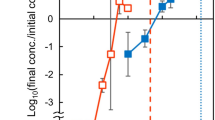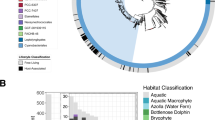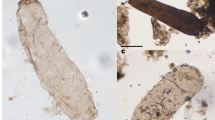Abstract
Cyanobacteria have had a pivotal role in the history of life on Earth being the first organisms to perform oxygenic photosynthesis, which changed the atmospheric chemistry and allowed the evolution of aerobic Eukarya. Chloroplasts are the cellular organelles of photoautotrophic eukaryotes in which most portions of photosynthesis occur. Although the initial suggestion that cyanobacteria are the ancestors of chloroplasts was greeted with skepticism, the idea is now widely accepted. Here we attempt to resolve and date the cyanobacterial ancestry of the chloroplast using phylogenetic analysis and molecular clocks. We found that chloroplasts form a monophyletic lineage, are most closely related to subsection-I, N2-fixing unicellular cyanobacteria (Order Chroococcales), and heterocyst-forming Order Nostocales cyanobacteria are their sister group. Nostocales and Chroococcales appeared during the Paleoproterozoic and chloroplasts appeared in the mid-Proterozoic. The capability of N2 fixation in cyanobacteria may have appeared only once during the late Archaean and early Proterozoic eons. Furthermore, we found that oxygen-evolving cyanobacteria could have appeared in the Archaean. Our results suggest that a free-living cyanobacterium with the capacity to store starch through oxygenic CO2 fixation, and to fix atmospheric N2, would be a very important intracellular acquisition, which, as can be recounted today from several lines of evidence, would have become the chloroplast by endosymbiosis.
Similar content being viewed by others
Log in or create a free account to read this content
Gain free access to this article, as well as selected content from this journal and more on nature.com
or
References
Bhattacharya D, Medlin L . (1995). The phylogeny of plastids: a review based on comparison of small-subunit ribosomal RNA coding regions. J Phycol 31: 489–498.
Bergman BJ, Gallon J, Rai AN, Stal L . (1997). Nitrogen fixing non-heterocystous cyanobacteria. FEMS Microbiol Rev 19: 139–185.
Brocks JJ, Logan GA, Buick R, Summons RE . (1999). Archaean molecular fossils and the early rise of eukaryotes. Science 285: 1033–1036.
Canfield DE, Habicht K, Thamdrup B . (2000). The archaean sulfur cycle and the early history of atmospheric oxygen. Science 288: 658–661.
Capone DG, Zehr J, Paerl H, Bergman B, Carpenter EJ . (1997). Trichodesmium: a globally significant marine cyanobacterium. Science 276: 1221–1229.
Castenholz RW . (2001). Cyanobacteria et al. In: Boone DR, Castenholz RW, Garrity GM (eds). Bergey's Manual of Systematic Bacteriology, 2nd Edn, Vol. 1. The Archaea and the Deeply Branching and Phototrophic Bacteria Springer–Verlag: NY, pp 473–597.
Cavalier-Smith T . (2006). Cell evolution and Earth history: stasis and revolution. Philos Trans R Soc B 361: 969–1006.
Delwiche CF, Kuhsel M, Palmer JD . (1995). Phylogenetic analysis of tufA sequences indicates a cyanobacterial origin of all plastids. Mol Phylogenet Evol 4: 110–128.
Deschamps P, Colleoni C, Nakamura Y, Suzuki E, Putaux JL, Buléon A et al. (2008). Metabolic symbiosis and the birth of the plant kingdom. Mol Biol Evol 25: 536–548.
Deusche O, Landan G, Roettger M, Gruenheit N, Kowallik KV, Allen JF et al. (2008). Genes of cyanobacterial origin in plant nuclear genomes point to a heterocyst-forming plastid ancestor. Mol Biol Evol 25: 748–761.
Dismukes GC, Klimov VV, Kozlov YN, Tyryshkin A . (2001). The origin of atmospheric oxygen on Earth: the innovation of oxygenic photosynthesis. Proc Natl Acad Sci USA 98: 2170–2175.
Douglas SE . (1998). Plastid evolution: origins, diversity, trends. Curr Opin Genet Dev 8: 655–661.
Eigenbrode JL, Freeman KH . (2006). Late Archaean rise of aerobic microbial ecosystems. Proc Natl Acad Sci USA 103: 15759–15764.
Falcón LI, Carpenter EJ, Cipriano F, Bergman B, Capone DG . (2004). N2 fixation by unicellular bacterioplankton from the Atlantic and Pacific oceans: phylogeny and in situ rates. Appl Environ Microbiol 70: 765–770.
Falcón LI, Lindwall S, Bauer K, Bergman B, Carpenter EJ . (2005). Ultrastructure analysis of unicellular N2-fixing cyanobacteria isolated from the tropical North Atlantic and subtropical North Pacific oceans. J Phycol 40: 1074–1078.
Fennel K, Follows M, Falkowski PG . (2005). The co-evolution of the nitrogen, carbon and oxygen cycles in the Proterozoic ocean. Am J Sci 305: 526–545.
Hackett JD, Yoon HS, Butterfield NJ, Sanderson MJ, Bhattacharya D . (2007). Plastid endosymbiosis: sources and timing of the major events. In: Falkowski P, Knoll A (eds). Evolution of Primary Producers in the Sea. Academic Press: San Diego, CA, pp 109–132.
Hayes JM . (1994). Global methanotrophy at the archaean-proterozoic transition. In: Bengtson S, Bergstrom J, Gonzalo V, Knoll A (eds). Early Life on Earth, Nobel Symposium, Columbia, University Press: New York, pp 220–239.
Haselkorn R . (2007). Heterocyst differentiation and nitrogen fixation in cyanobacteria. In Elmerich C, Newton WE (eds). Associative and Endophytic Nitrogen-Fixing Bacteria and Cyanobacterial Associations. Springer, Dordrecht: the Netherlands. pp 233–255.
Hedges SB, Blair JE, Venturini ML, Shoe JL . (2004). A molecular timescale of eukaryote evolution and the rise of complex multicellular life. BMC Ecol Biol 4: 1–9; 842.
Holland HD . (2002). Volcanic gases, black smokers, and the Great Oxidation Event. Geochim Cosmochim Acta 66: 3811–3826.
Huelsenbeck JP, Ronquist FR . (2001). MrBayes: Bayesian inference of phylogenetic trees. Bioinformatics 17: 754–755.
Kenrick P, Crane PR . (1997). The origin and early diversification of land plants—a cladistic study. Smithsonian Institution Press: Washington and London, 441 p.
Kopp R, Kirshvink J, Hilburn I, Nash C . (2005). The Paleoproterozoic snowball Earth: a climate disaster triggered by the evolution of photosynthesis. Proc Natl Acad Sci USA 102: 131–136.
Martin W, Rujan T, Richly E, Hansen A, Cornelsen S, Lins T et al. (2002). Evolutionary analysis of Arabidopsis, cyanobacterial, and chloroplast genomes reveals plastid phylogeny and thousands of cyanobacterial genes in the nucleus. Proc Natl Acad Sci USA 99: 12246–12251.
Maruyama S, Santosh M . (2008). Models on snowball Earth and Cambrian explosion: a synopsis. Gondwana Res 14: 22–32.
McFadden GI, van Dooren G . (2004). Evolution: red algal genome affirms a common origin of all plastids. Curr Biol 14: R514–R516.
Michaels AF, Karl DM, Capone DG . (2001). Element stoichiometry, new production and nitrogen fixation. Oceanography 14: 68–77.
Montoya JP, Holl CM, Zehr JP, Hansen A, Villareal TA, Capone DG . (2004). High rates of N2 fixation by unicellular diazotrophs in the oligotrophic Pacific Ocean. Nature 430: 1027–1032.
Moreira D, Le Guyader H, Philippe H . (2000). The origin of red algae and the evolution of chloroplasts. Nature 406: 69–72.
Nelissen B, Van de Peer Y, Wilmotte A, De Wachter R . (1995). An early origin of plastids within the cyanobacterial divergence is suggested by evolutionary trees based on complete 16S rRNA sequences. Mol Biol Evol 12: 1166–1173.
Posada D, Buckley TR . (2004). Model selection and model averaging in phylogenetics: advantages of Akaike Information Criterion and Bayesian approaches over likelihood ratio tests. Syst Biol 53: 793–808.
Posada D, Crandall KA . (1998). Modeltest: testing the model of DNA substitution. Bioinformatics 14: 817–818.
Raven JA, Allen JF . (2003). Genomics and chloroplast evolution: what did cyanobacteria do for plants? Gen Biol 4: 209.
Raymond J, Siefert JL, Staples CR, Blankenship RE . (2004). The natural history of nitrogen fixation. Mol Biol Evol 21: 541–554.
Rodriguez-Ezpeleta N, Brinkmann H, Burey SC, Roure B, Burger G, Loffelhardt W et al. (2005). Monophyly of primary photosynthetic eukaryotes: green plants, red algae and glaucophytes. Curr Biol 15: 1325–1330.
Rosing MT, Frei R . (2004). U-rich Archaean sea-floor sediments from Greenland—indications of >3700 Ma oxygenic photosynthesis. Earth Planet Sci Lett 217: 237–244.
Sanderson MJ . (2002). Estimating absolute rates of molecular evolution and divergence times: a penalized likelihood approach. Mol Biol Evol 19: 101–109.
Sanderson MJ . (2006). r8s version 1.71. Analysis of rates (‘r8s’) of evolution. Section of Evolution and Ecology. Univeristy of California: Davis, http://loco.biosci.arizona.edu/r8s/.
Schopf JW . (2006). Fossil evidence of Archaean life. Philos Trans R Soc B 361: 869–885.
Schopf JW, Packer BM . (1987). Early Archaean (3.3–3.5 Ga-old) fossil microorganisms from the Warrawoona Group, Western Australia. Science 237: 70–73.
Shi T, Falkowski PG . (2008). Genome evolution in cyanobacteria: the stable core and the variable shell. Proc Natl Acad Sci USA 105: 2510–2515.
Stiller JW, Reel DC, Johnson JC . (2003). A single origin of plastids revisited: convergent evolution in organellar genome content. J Phycol 39: 95–105.
Swofford DL . (2002) PAUP*: Phylogenetic analysis using parsimony (* and other methods) version 4.0b 10 for Macintosh, and 4.0b 10 for UNIX Sinauer Associates: Sunderland, MA.
Tomitani A, Knoll AH, Cavanaugh C, Ohno T . (2006). The evolutionary diversification of cyanobacteria: molecular-phylogenetic and paleontological perspectives. Proc Natl Acad Sci USA 103: 5442–5447.
Turner S, Pryer KM, Miao VP, Palmer JD . (1999). Investigating deep phylogenetic relationships among cyanobacteria and plastids by small subunit rRNA sequence analysis. J Eukaryot Microbiol 46: 327–338.
Waterbury JB . 1991. The cyanobacteria: isolation, purification and identification. In: Balows A, Dworkin M, Schlegel HG, Truper H (eds). The Prokaryotes 2nd Edn. Springer-Verlag: Berlin, pp. 2058–2078.
Yoon HS, Hackett JD, Ciniglia C, Pinto G, Bhattacharya D . (2004). A molecular timeline for the origin of photosynthetic eukaryotes. Mol Biol Evol 21: 809–818.
Zehr JP, Bench SR, Carter BJ, Hewson I, Niazi F, Shi T et al. (2008). Globally distributed uncultivated oceanic N2-fixing cyanobacteria lack oxygenic photosystem II. Science 322: 1110–1112.
Acknowledgements
We thank E J Carpenter, M Clegg, LE Eguiarte, MF Campa, SL Gómez and JW Schopf for critical discussions on the paper. LIF and SM are funded by CONACyT (Mexico). LIF thanks support from STINT (Sweden).
Author information
Authors and Affiliations
Corresponding author
Rights and permissions
About this article
Cite this article
Falcón, L., Magallón, S. & Castillo, A. Dating the cyanobacterial ancestor of the chloroplast. ISME J 4, 777–783 (2010). https://doi.org/10.1038/ismej.2010.2
Received:
Revised:
Accepted:
Published:
Issue date:
DOI: https://doi.org/10.1038/ismej.2010.2
Keywords
This article is cited by
-
Spatial fragmentation in the distribution of diatom endosymbionts from the taxonomically clarified dinophyte Kryptoperidinium triquetrum (= Kryptoperidinium foliaceum, Peridiniales)
Scientific Reports (2023)
-
Genomic characterization and molecular dating of the novel bacterium Permianibacter aggregans HW001T, which originated from Permian ground water
Marine Life Science & Technology (2023)
-
Reversible protein phosphorylation in higher plants: focus on state transitions
Biophysical Reviews (2023)
-
Expression of a periplasmic β-carbonic anhydrase (CA) gene is positively correlated with HCO3- utilization by the gametophytes of Saccharina japonica (Phaeophyceae, Ochrophyta)
Journal of Applied Phycology (2023)
-
Can genomics tools assist in gaining insights from the aquatic angiosperms to transform crop plants with multiple carbon concentrating mechanisms to adapt and yield better in challenging environment?
Plant Physiology Reports (2022)



